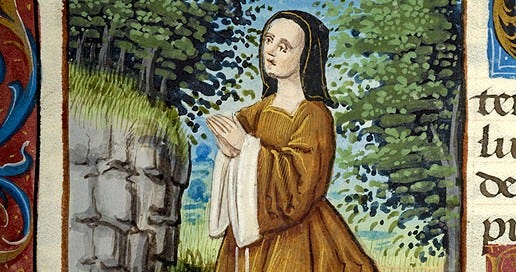Medieval Wisdom for Those Who Pray
Julian of Norwich explores the mystery of Christian prayer
After so many years of reading, searching, studying, and reflecting, I still find that some of the most enduring questions of the spiritual life are also the most basic—the sort that children ask, because they still have peace in their souls, as the Master said: “Blessed are the peacemakers, for they shall be called the children of God.”
Julian of Norwich, the medieval anchoress whose writings we discussed on Sunday, was childlike, in the best possible way. This quality shines forth from her prose, yet without distracting the reader from the brilliance of her thought, the depth of her faith, and the intensity of her mystical love. She is not afraid to wonder about “simple” things that the theologians explained long ago, because she wants to understand them in her own way, and in accord with the graces that she, personally, has received. She knows that she is not a monastic philosopher or an illustrious scholar, but she has given her heart to Heaven, and furthermore, she has something that most of them never had: a vision—a seeing, a showing—of Christ and His Mother. “I saw”: this is the act, the belief, that echoes through her writings.
Oure lorde shewed me … oure lady Sainte Marye. And here he shewed me in thre times: the firste was as she consayved; the seconde was as sho were in hire sorowes undere the crosse; and the thrid as sho is nowe, in likinge, wirshippe, and joye. And efter this, oure lorde shewed him to me mare glorified as to my sight than I sawe him before.
[Our lord showed me … our lady Saint Mary. And here he shewed me on three occasions: the first was as she conceived; the second was as she were in her sorrows under the cross; and the third as she is now, in pleasure, honor, and joy. And after this, our lord showed himself to me more glorified as to my sight than I saw him before.]
When she wants to convey “this is how I understand something,” she says, “as to my sight”:
For the most fulhede of joy that we shalle have, as to my sight, is this marvelous curtesy and homelyhede of oure fader that is oure maker, in oure lorde Jhesu Crist that is oure broder and oure savior.
[For the greatest fullness of joy that we shall have, as to my sight, is this wondrous courtesy and intimacy of our father that is our maker, in our lord Jesus Christ that is our brother and our savior.]
What she sees above all is a suffering God. The Passion is her gateway to knowledge, to wisdom, to transcendence. Her philosophy is found in the Blood of Christ, and her holiness is to be numbered among “his tru lovers.” A special power is in her words because she tells us not so much what she thinks—what she has analyzed, deduced, inferred—but what she beholds.
And I behelde and marveyled how it might be…. The garlonde of thornes was deyde [dyed] with the blode. And that other garlond and the hede, all was one coloure, as clotered [clotted] blode when it was dried. The skinne and the fleshe that semed of the face and of the body was smalle rumpelde [slightly wrinkled], with a tawny coloure, like a drye bord whan it is aged, and the face more browne than the body.
It is not just supernatural images that she “sees.” Abstract realities and mysterious insights are also somehow before her eyes.
I sawe God in a pointe—that es, in mine understandinge—by whilke [which] sight I sawe that he es in alle thinge.… I merveylede [marveled] in this sight with a softe drede [a gentle awe], and thought: “Whate es sinne?” For I sawe trulye that God dothe alle thinge.
Keep reading with a 7-day free trial
Subscribe to Via Mediaevalis to keep reading this post and get 7 days of free access to the full post archives.





